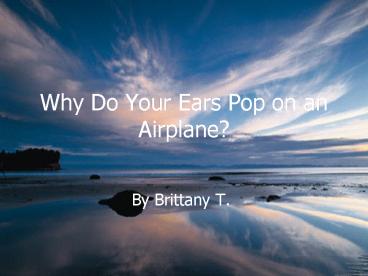Why Do Your Ears Pop on an Airplane? - PowerPoint PPT Presentation
1 / 10
Title:
Why Do Your Ears Pop on an Airplane?
Description:
Eardrum- The tympanic membrane of the ear, or tympanum, the membrane that ... middle ear- The middle ear consists of the ear drum and, beyond it, a cavity. ... – PowerPoint PPT presentation
Number of Views:77
Avg rating:3.0/5.0
Title: Why Do Your Ears Pop on an Airplane?
1
Why Do Your Ears Pop on an Airplane?
- By Brittany T.
2
Introduction
- Ever been on an airplane, and had your ears hurt
really bad? Have you ever heard a baby cry while
your landing, while the mother frantically tries
to calm the child down? Well, all of these
answers you can find in my website. They all
relate to the question, why do your ears pop on
an airplane? What does it have to do with? Just
read on and youll find out.
3
Science Page
- Why do your ears pop in an airplane? That is the
question that most people ask while on an
airplane and are experiencing pain in their ears.
- Air pressure has a lot to do with it. Pressure is
the exertion of force on a surface by an object. - While at sea level the air pressure is very high
and the higher in altitude, you get the lower air
pressure becomes, and in airplanes you go very
high. - Altitude is the height of anything above a given
planetary reference plane above sea level on
earth.
4
More science
- During ascend and descend there is a
rapid change in air pressure. The middle ear is
what causes discomfort during air travel because
it is extremely sensitive to changes in air
pressure. Normally, when you swallow, your ears
make a pop because a small bubble has entered
your middle ear your nose. It then passes through
the Eustachian tube, a membrane-lined tube about
the size of a pencil lead that connects the back
of the nose with the middle ear. But since the
air pressure is changing your middle ear is also
experiencing changes in air pressure. To maintain
comfort, the Eustachian tube must open frequently
and wide enough to equalize the changes in air
pressure. This is why some people chew gum, yawn,
or suck on candy during air travel. All of these
acts open the Eustachian tube to let the air
bubble out and reduce the pain.
5
..more science
- It seems so simple to just open your
mouth, right? Well, what if you had a cold or
sinus infection? Not so simple then, huh? - Your sinuses are connected to your ears
by the Eustachian tube, and if your sinuses are
infected then that makes your ears even more
vulnerable. For children, babies, or infants, the
pain is more severe because their Eustachian tube
is much smaller than teenagers or adults. Also
they cannot intentionally pop their ears. To
help, you might be able to give them a bottle or
pacifier to suck on, or some cheerios to chew.
This will allow them to open their Eustachian
tube just like adults.
6
Some Photos
7
Vocabulary
- Force- A push or pull exerted on an object to
make it accelerate. - Altitude- the height of anything above a given
planetary reference plane, esp. above sea level
on earth. - Equilibrium- a state of rest or balance due to
the equal action of opposing forces. - equal balance between any powers, influences,
- Eustachian tube- a membrane-lined tube about the
size of a pencil lead that connects the back of
the nose with the middle ear. - sinus infection- Of abrupt onset, in reference to
a disease. Acute often also connotes an illness
that is of short duration, rapidly progressive,
and in need of urgent care. - Eardrum- The tympanic membrane of the ear, or
tympanum, the membrane that separates the middle
ear from the external ear. - pressure- the exertion of force upon a surface by
an object - middle ear- The middle ear consists of the ear
drum and, beyond it, a cavity. This cavity is
connected via a canal. The Eustachian tube
permits the gas pressure in the middle ear cavity
to adjust to external air pressure. The middle
ear cavity also contains a chain of 3 little
bones that connect the ear drum to the internal
ear. - membrane- A very thin layer of tissue that covers
a surface.
8
Introduction to Graph
- I had a biggie physics question that I had to
do this PowerPoint on. My question was, Why do
your ears pop in an airplane? I asked 20 adults
this question and recorded their responses in a
graph. On the following slide you will see how
many people actually know the answer to this
question.
9
Survey Graph
10
Related Links
- http//www.entnet.org/healthinfo/ears/altitude.cfm
- AAO-HNS- This website had a ton of information
about the middle ear and altitude. - http//airtravel.about.com/library/weekly/aa061502
a.htm - About- This website has helped me find
information about how to unblock your ears and
also a lot about air travel in general. - http//www.medicinenet.com/script/main/art.asp?art
iclekey60597 - Medicine Net- This page made available a ton of
cold and sinus information relating to air
travel. It also did a wonderful job of
explaining why your ears pop in airplanes. - http//wright.nasa.gov/airplane/pressure.html
- NASA- This website gave me a ton of facts about
pressure. It also had some really good diagrams
explaining pressure.
Ms. Pecks Homepage
Other Biggie Questions































